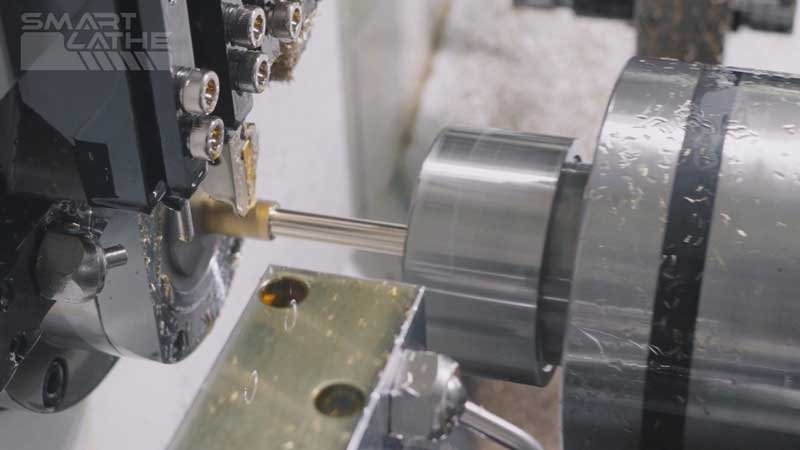Twin-Spindle Swiss-Type Lathe: A Key Tool for Precision Manufacturing in the Future
In modern manufacturing, with the increasing diversity and complexity of product demands, the requirements for machining equipment have also risen. The twin-spindle Swiss-type lathe, as a high-efficiency, precision machining tool, is gradually becoming the preferred choice in many high-end manufacturing sectors. It represents not only a technological innovation but also a crucial tool for driving production efficiency and improving product quality.
The SW-266 twin-spindle Swiss-type lathe is a high-performance CNC lathe meticulously developed by our company, designed specifically to meet the needs of modern manufacturing for high-efficiency, high-precision machining. This model integrates advanced technology and innovative design concepts, offering users excellent machining capabilities and flexible production solutions.
1. Synchronized Machining Capability
One of the most significant features of the twin-spindle design is its ability to perform synchronized machining. Both spindles can work simultaneously, such as having spindle one performs turning operations while spindle two performs drilling or tapping. This synchronized machining capability greatly reduces the time needed for workpiece repositioning and clamping, thereby improving overall production efficiency. The twin-spindle design allows multiple machining processes to be integrated into a single machine. For instance, the first spindle can perform rough machining, while the second spindle handles finishing or other operations. In this way, multiple processes can be completed in a single clamping session, avoiding the positioning errors caused by repeated clamping and improving machining accuracy.
2. Workpiece Relay Machining
Another important feature of the twin-spindle Swiss-type lathe is the relay machining function. Typically, after the first spindle completes the initial machining, the workpiece is automatically transferred to the second spindle for subsequent operations. This design allows the workpiece to undergo the entire process from rough machining to finishing without changing the clamping state, ensuring consistency and high precision in machining.
3. Guide-Bushing Support for Workpieces
One of the biggest advantages of Swiss-type lathes is the way they support workpieces. In a Swiss-type lathe, the workpiece is tightly supported by a guide bushing, with the cutting position very close to the bushing, ensuring stability during the machining process. This design greatly reduces bending and vibration of the workpiece during machining, especially when processing long workpieces, thus ensuring machining accuracy and surface quality. Due to the stability maintained during the machining process, long workpieces can consistently maintain high precision throughout the entire process. The guide bushing support allows the tool to cut very close to the workpiece, reducing vibrations and deviations caused by excessive workpiece length. This makes Swiss-type lathes particularly suitable for machining long, high-precision parts such as guidewires in medical devices and slender shafts in aerospace components. When machining long workpieces on a Swiss-type lathe, full support and stability reduce material waste through smaller cutting allowances. Additionally, minimizing repeated clamping and transfers reduces human error during machining, thus lowering the defect rate and production costs. Swiss-type lathes use a unique cutting method that maintains workpiece stability while achieving efficient cutting. This capability is especially advantageous when handling long workpieces, allowing material to be quickly removed, thus shortening machining time. Moreover, Swiss-type lathes are often equipped with automatic feeding systems, making them highly effective in mass production of long workpieces and further improving production efficiency. The SW-226 model can machine workpieces up to 2.5 times their diameter without a guide bushing and can process workpieces up to 190mm in length with a guide bushing. The machine's tooling system includes a 5-position 12-tool holder and a 16-tool holder.
4. Machining of High-Hardness Materials
Machining high-hardness materials (such as stainless steel, titanium alloys, and hard alloys) often presents challenges. Swiss-type lathes excel in overcoming these challenges thanks to their unique design and precise control. High-hardness materials cause significant tool wear, but the Swiss-type lathe reduces cutting forces and cutting temperatures by precisely controlling the cutting conditions, thus extending tool life. The lathe’s design ensures that the tool operates in the optimal cutting position, and the high-efficiency cooling system removes heat in a timely manner, reducing tool wear. This is especially beneficial when machining hard materials. When machining high-hardness materials, Swiss-type lathes maintain a stable cutting process through their high rigidity structure and precise feed control. Even when facing the high cutting resistance of hard materials, Swiss-type lathes keep the cutting path consistent, ensuring high surface quality and preventing defects or cracks. High-hardness materials often generate significant heat during machining, which, if not dissipated promptly, can lead to rapid tool wear or even workpiece deformation. Swiss-type lathes are typically equipped with high-efficiency cooling systems that rapidly deliver coolant to the cutting area, ensuring temperature control within a reasonable range and improving machining quality.





